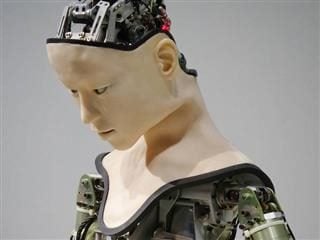AI language models could help diagnose schizophrenia
SOURCE: HTTPS://WWW.SCIENCEDAILY.COM/
OCT 09, 2023
How Industry 5.0 Might Deliver Human-Centric Work Cultures
SOURCE: CMSWIRE.COM
JAN 21, 2022

Industry 4.0 technologies have left the world awash in data. The fourth wave of industrialization also gave us the tools to mine that data for intelligence and insights. We are now busy applying those insights to change the way we live, play, learn and earn. Today, we have cheap and easy access to the fundamental ingredients of Industry 4.0: smart sensors, data, analytics, cloud, 3-D printing, the internet of things (IoT), artificial intelligence, augmented reality, machine learning, blockchain, digital twins, and horizontal and vertical system integration. Using these, businesses are rewriting the rules of the game.
Industry 4.0 is increasing production, lowering costs and improving profit margins. It is keeping customers happy with addictive personalization and dazzling experiences. This is how we wanted the world to be.
Or is it?
The progress enabled by Industry 4.0 are raising a disturbing question: Are humans being sidelined? A group of researchers confirmed that suspicion in early 2021. They found that “the attention to human factors has been particularly sparse” with Industry 4.0. That imbalance must be set right. Industry 5.0 will be tasked to accomplish this.
Industry 5.0's approach has humans and machine working seamlessly together, in synergistic environments. I have argued before that we need data sciences as the foundation for augmented intelligence (and not artificial intelligence) which binds the human-machine partnership. I have also argued that the future is not about replacement but "up-placement."
The idea of a human-machine partnership goes beyond the horizon of smart factories and automated systems. It combines technological precision with the unique powers of human perception and resourcefulness. It believes that humans and machines are complementary rather than competitors. It puts people back into the value chain — so the outcome is more than the sum of the parts.
Industry 5.0 is the next revolution. In 2022, we will hear it mentioned more often in strategy meetings and at future-focused events. This is because intelligent leaders already know that a better future awaits in building a positive and symbiotic relationship between machines and the workforce. As Esben Østergaard, co-founder and CTO of Universal Robots, and a winner of the Engelberger Robotics Award (think of it as the Nobel prize of automation) said, “Industry 5.0 will make the factory a place where creative people can come and work, to create a more personalized and human experience for workers and their customers.” Research by Oracle also points to why such a collaborative approach will succeed: with the increased adoption of AI in the workplace, people have begun to place more trust in robots (64%) than their managers!
The European Union has recognized that Industry 5.0 builds upon the investments made in Industry 4.0 and puts businesses in the position to “achieve societal goals beyond jobs and growth to become a resilient provider of prosperity by … placing the well-being of the industry worker at the center of the production process.” In an early 2021 publication, "Industry 5.0: Towards a Sustainable, Human-centric, and Resilient European Industry," the EU discusses how Industry 5.0 must leverage the workforce while capturing the value of new technologies.
What does Industry 5.0 look like? What does it produce? How does it deliver on its promise? Does it mean making additional investments on top those made in Industry 4.0?
Some products and services provide a glimpse of how Industry 5.0 will change things around us through re-humanization. For example, an autonomous delivery robot built by an Estonian technology company tackles the traffic congestion and pollution caused by the growth in doorstep deliveries — a problem that the massive upsurge in home deliveries driven by the COVID-19 pandemic amplified. The current delivery methodology is unsustainable, but the tiny energy-efficient and autonomous delivery robot uses cameras, GPS, two-way audio, security processes and mobile apps — all things Industry 4.0 — to safely deliver food, medicines and other packages. The important part is that the robot is not 100% autonomous. A human oversees the delivery and can take control of the robot at any time.
Imagine having a personal bot at work that is roles-based, one that can perform a number of tasks such as those required of application developers or testers. Or imagine a bot with expertise in select financial or human resource processes that an organization’s financial controller or CHRO can use as collaborators. These co-bots would increase the workforce's productivity. But underlying this ability is the real reason organizations will want a hybrid workforce made up of collaborative humans and bots: A synergistic environment allows organizations to remain flexible and alter processes using expert human cognition — a skill that today’s bots lack.
Fortunately, the technological components required are, largely, already in place thanks to Industry 4.0. By altering the approach to harnessing these technologies and keeping humans at the center, organizations can unlock better ROI from their Industry 4.0 investments. Industry leaders with foresight know this is an incremental change. It might require additional investments in technologies like natural language processing (NLP), gesture recognition, intent analysis, and improved human-machine interface (HMI) to make the collaboration seamless — and doubtless, more intuitive, friendly and fun. But Industry 5.0 cannot be delayed. Because we know there is nothing more important than building and nurturing employee-centric work cultures.
Kalyan Kumar (KK) plays the role of Global CTO & Head - Ecosystems for HCL Technologies. He is actively involved in Product & Technology Strategy, Strategic Partner Ecosystem, Startup incubation, Open Innovation/Open Source, Enterprise Technology Office and supports the company’s organic/inorganic initiatives.
LATEST NEWS
WHAT'S TRENDING


Data Science
5 Imaginative Data Science Projects That Can Make Your Portfolio Stand Out
OCT 05, 2022

SOURCE: HTTPS://WWW.SCIENCEDAILY.COM/
OCT 09, 2023
SOURCE: HTTPS://WWW.THEROBOTREPORT.COM/
SEP 30, 2023
SOURCE: HTTPS://WWW.SCIENCEDAILY.COM/
AUG 08, 2023
SOURCE: HOUSTON.INNOVATIONMAP.COM
OCT 03, 2022
SOURCE: MEDCITYNEWS.COM
OCT 06, 2022